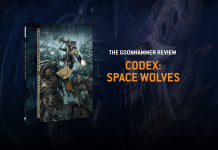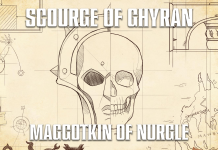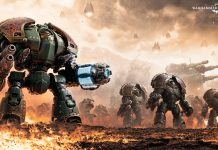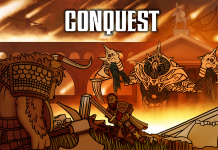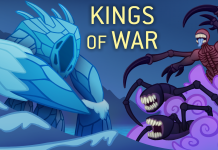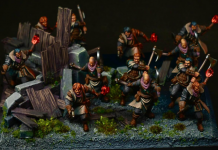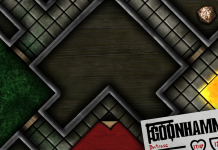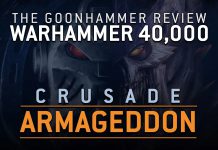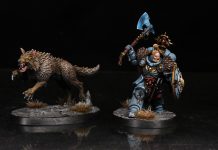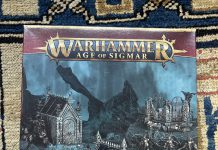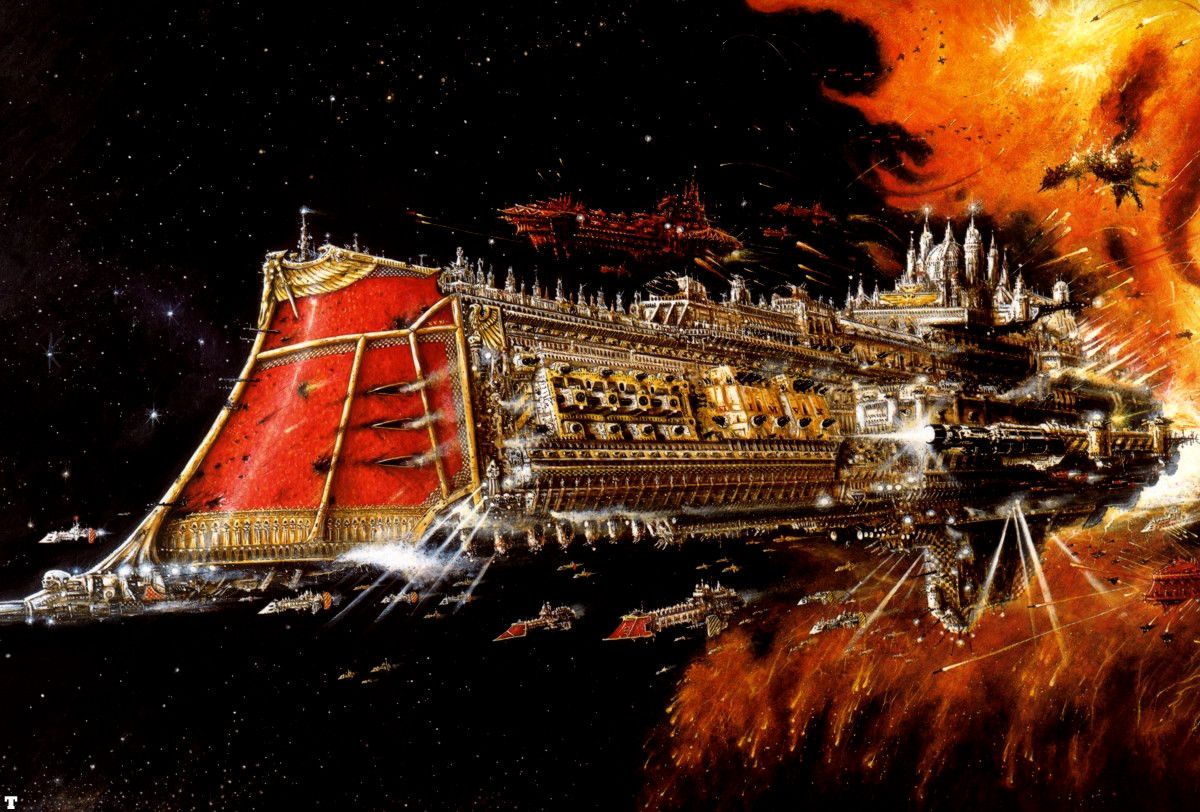Battlefleet Gothic (BFG) is a game for those among us who really enjoy the setting of the Warhammer 40,000 universe but feel it’s missing a certain flare for space-faring gothic cathedrals, comically oversized weapons batteries exchanging broadsides, and metric blue-whippy measuring sticks. It’s also the best game GW ever produced, and we’ll fight you if you disagree. There’s just something special about an Eldar corsair fleet gracefully dodging in and out of asteroid fields, plinking off Ork vessels with ease, only to have an exasperated Ork Warboss order a suicidal all ahead full into the asteroid field heedlessly plowing into monster space rocks and wraithbone hulls alike.
Over the next few articles we’ll explore the setting, factions, and mechanics of the BFG universe. We’ll talk about why you should take one fleet or the other depending on your style, rage along with you at Eldar bullshit, and fondly reflect on a time when Necrons phased out because they were so laughably good. We’ll cover content in the following areas:
Part One: Why You Should Play, How to Get Started, Game Setting, & Game Mechanics
Part Two: The Core Fleets
Part Three: Armada and Expansion Fleets
Part Four: Tactics and Expanded Play
For a review of the newest Battlefleet Gothic video game, Battlefleet Gothic: Armada 2 please see J B’s article.
Why Should I Resurrect This Old, Dead Game?
At the time of writing this article, Battlefleet Gothic has been out of print for over 6 years, and even when it was alive, it didn’t benefit from the same level of support as GW’s flagship (what cruel irony) products, 40k and what was then Warhammer Fantasy Battles. In many parts of the US, it could be downright hard to find minis for BFG, and even if you could, wrangling someone else into playing it wasn’t always the easiest thing to do. Fleet games add several additional systems to keep track of on top of what you’re probably used to dealing with from other wargames – things with strange and frightening names like “firing arcs” and “manoeuvre values” and “the Gunnery Table” – that complicate the process of shoving your models across the board and forcing your opponent to pick theirs up. Add to that at least four separate categories of weapons (each with their own rules), list building options that can be difficult to tell apart until you get a few games under your belt, and a heaping helping of faction-specific rules and abilities that make each fleet approach even the most basic actions in completely different ways, and you’ve got a lot of information to digest and incorporate into your game before you’ll be able to hang with the grizzled veteran admirals out there.
But we think it’s worth looking past all that to the game that lies beneath the complexity. Adding this sort of crunch to your game opens up strategies and tactics that just aren’t possible in more abstracted games like 40k or AoS. Your nimble escort ships can duck and weave through incoming fire to exploit an enemy cruiser’s limited maneuverability and pump fire into its vulnerable engines, setting it up to get torn apart by the massed weapon batteries of your ships of the line. Your Space Marine fleet’s Battle Barge can make a daring attack run, disgorging its boarding torpedoes full of gene-wrought super soldiers bent on turning the tide of a battle taking place over tens of thousands of square kilometers with nothing more than bolter, chainsword, and the Emperor’s grace. A Chaos battlegroup might think they’ve drawn a bead on your Aeldari Corsair fleet, only for the sleek and agile cruisers to ride the solar wind and slip into your opponents’ forward arc so they can rake their pulsar lances down the length of their prey, rendering them into so much space dust.
And there’s your reason. Battlefleet Gothic is a game that’s massive in scope and has a lot going on, but it needs to be if it’s going to capture the scale of naval engagements in the far-flung future. The crunch in the rules isn’t gratuitous, but instead has a very clear purpose: it’s meant to give you a front-row seat to some of the most spectacular battles that the 41st millenium has to offer. If the idea of planning out your deployment to set up a maneuver trap for your opponent 3 turns down the line makes you shiver with anticipation, if your heart leaps from your chest in exultation at the thought of a well executed Crossing of the T, or if you’ve ever felt a deep and abiding kinship with Rear Admiral David Farragut, then on behalf of the crew here at Goonhammer we just want to say this:
You’re among friends.

What Do I Need to Get Started?
The unfortunate reality is that BFG is a ‘dead’ game. It’s unsupported by Games Workshop with the latest release being a warehouse-clearing ‘re-release’ in 2013. The good news is that the rules are all free to download and it really does not take much to get your fleet into ship-shape and launched into the void. If you’re a Tyranid player you can just use spare parts from a Warriors kit (or just the whole thing, it’s really for the best) and if you’re a Necron player you can just buy a Tombship and solo anything because lol BFG Necrons are ridiculous. Honestly, the hardest part about picking up BFG will be to find a reliable opponent – so convince your friend that what they really need in their lives is more space games and plas-… pewter to paint so that you can duke it out over your favorite gas clouds. We’ll go over what you need to get started and then how you can find it:
What You Need:
- The rules
- A fleet or two
- Space terrain and board
- Game supplies
- Metric rulers or measuring tapes
- Six-sided dice
- Scatter dice
- Game markers:
- Orders dice
- An opponent (the hardest part)
- Your mitts
Finding the Rules:
Battlefleet Gothic rules were once freely available on the GW website. However, at some point following the re-release these were taken down. The rules can now be found by google searching but if you’re looking for a good source, you can look here. An annual BFG tournament is also held at Adepticon – the rules and addendum can be found in the event’s resources page. In terms of list-building, there exist Battlescribe files for Battlefleet Gothic which include nearly all fleet listings and options, last updated late in 2019.
The Fleets:
Perhaps the second hardest thing to come by on this list. The miniatures for this game have been out of production for a considerable amount of time. As a result, the fleets themselves may be difficult to find or cost two left arms to purchase. There are options, however, and at the end of the day most factions do not require many miniatures to field a full-sized fleet. To give you an idea, fleet engagements may range from 750 points (a small patrol skirmish) to 2,500 points (a very large armada) which may range from as few as 3-4 models to 20-30. I don’t believe I’ve ever played a one-on-one game larger than 2,500 points per player, and wanting more than that is asking for old Apocalypse levels of time suck. So where to find these models?
- Ebay – the easiest source – there are a plethora of options available covering nearly every miniature ever made for the game. The caveat is that this also likely to come at a significant expense.
- Shapeways – Unfortunately Shapeways does not provide everything for BFG fleets. However, the majority of original designs and some limited release designs can be found here, especially for Imperial and Chaos fleets. The cost is cheaper in general than Ebay, but it’s not bottom barrel. When it comes to game supplies, Shapeways is a key resource and frankly, my preferred source.
- Bitz Bins – Every so often I’ll come across BFG ships in bitz boxes at local stores or at conventions. Often time you can find a bargain here as well. Original blisters are a diamond in the rough.
- Custom Ships – This is most pertinent to Tyranids – but the massive amount of 40k bits provide an excellent source to create your own unique looking ships, be they Necron, Eldar, Tau, Chaos, or Imperial. In my experience some of the most fantastic looking fleets have been custom.
- Stand-In Ships – Feel free to substitute other game designs that have some fantastic minis! All you need is consistency between vessel types and you can use stand-ins however you’d like! The only thing to account for is base sizes and firing arcs.
In reality, GW manufactured fleets can be expensive but they need not be. You can find options out there that will fit your needs, and to put this in perspective, if you’re already playing 40k, it’s actually much cheaper than starting up a new army or re-tailoring your current list options.
Space Terrain/Board:
The game is nominally played on a board somewhere between 4-6′ wide by 6-8′ long – at the time of its release 4×8′ boards were the standard of the day for all of GW’s games (I wish this was still the case) but really any size board will do as you begin your space dance. There exist star mats out there from companies like Frontline Gaming or other tabletop mat providers – however, a black felt sheet or spray painted board is just as useful and much cheaper. The basic rules provide general dimensions for different types of space phenomena with which you can populate your board. Primary terrain elements include:
- Planets/Moons
- Asteroid Fields
- Gas Clouds
- Warprifts
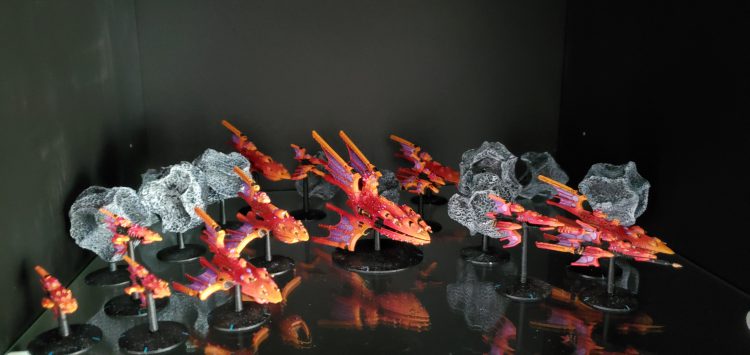
Building these items is rather easy. A leisurely stroll down any Michael’s or other craft store aisle will give you plenty of options to create all the terrain you could ever need. Felt is a common ‘base’ for asteroid fields, gas clouds, etc. However, small styrofoam balls that have been cut up, gouged, and painted create a wonderful looking asteroid field. If you want to go 3D on your gas clouds, cotton stretched out and spray painted in whatever color you want makes fantastic nebula effects. Building terrain in BFG is much more simplistic and easy than it is for other game systems like 40k, but it’s also much more impactful and interesting to the game. If you wanted, you could put together everything you need for a fully prepared board in only a few hours and a trip to the store. The relative simplicity also makes a board easier to spice up if you wanted to add lighting effects!
Game Supplies:
Here again you have a number of options, depending on how much effort or money you want to throw at the problem. At its most basic, every marker in the game can be as simple as printed paper template cutouts. Multiple pdf files exist that can be used for this exact purpose. For more immersive markers, Shapeways is again an excellent resource. Depending on your fleet’s needs, markers may include:
- 20+ Blast Markers
- 5-10x Torpedo Markers
- 5-10x Fighter Markers
- 5-10x Bomber Markers
- 5-10x Assault Boat Markers
- 5-10x Orders Dice/Markers
- 1x Nova Cannon Marker
- 1x Facing Dial
Most of the markers can be found in print out versions found here. Similar to the fleets, you can also find more durable and fun 3D markers at Shapeways.
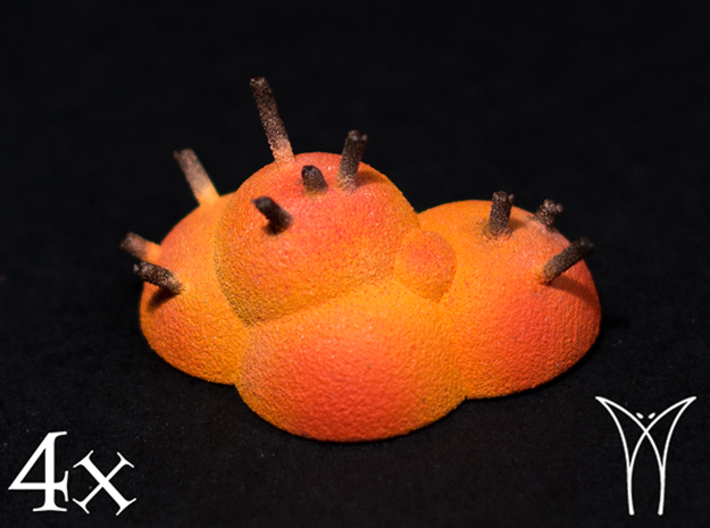
Other game supplies such as metric measuring tapes, or six-sided dice may be commonly found at any hobby store or your local FLGS. However, scatter dice are now defunct in most GW games. While you can still find them here and there, it may be best to simply order one online (eBay/Shapeways) or to simply create your own using any large dice and drawing an arrow on 4 sides, and a “hit” marker on 2 opposing sides.
Opponent:
Find someone who likes cool broadsides and pew pew noises and finagle them into a game with you. This is a cool game for cool people so you’ll be friends for life once you find the person willing to play.
What’s the Backstory?
Battlefleet Gothic outlines a lot of the original ‘fluff’ or lore of the Imperial Navy; its role and structure within the Imperium and its capabilities for warp travel. It also in many ways laid the groundwork for a lot of the story that would follow in the millennia since. The setting of the game takes place during the events of the Gothic War in M41 – Abbadon’s 12th Black Crusade. In telling the story of the opening moves of the war, the Hand of Darkness and Eye of Night would be introduced, relics which would go on to be important not just in the war, but later at the close of M41 as the 13th Black Crusade kicked off or as Roboute Guilliman seeks to close the Great Rift. Perhaps more important than the relics, the fabled Blackstone Fortresses were introduced – massive alien structures of unknown origins that would prove to be the doom of Cadia and the Cadian Gate.
The Gothic War officially kicked off in 143.M41 with a bevy of Warp Storms that isolated the Gothic Sector and cut it off from neighboring Imperial reinforcements. Abbadon led his vast fleets against the unprepared repair and resupply points of Battlefleet Gothic, commanded by Lord Admiral Ravensburg. Despite the attempts of Inquisitor Horst to determine the location of the impending attack, the forces of Chaos were successful in achieving surprise in the Gothic Sector – striking Imperial Navy ships in dock and resupply/refit ports in short, focused strikes leaving much of the fleet damaged, destroyed, or without facilities for repair. Underpinning the defense strategy of the Gothic Sector and anchoring six of its seventeen naval bases were six Blackstone Fortresses. All of these massive structures had been retrofitted by the Imperial Navy to serve as anchorages and bases of operation. These massive installations were never fully operable for the Imperium, but their core fed enough energy to facilitate operations and defenses that rivaled the strongest Imperial ports – they had never fallen to enemy forces. That changed abruptly when the first Blackstone Fortress (Blackstone IV) would fall to Chaos in the Rebo system – as the Chaos fleet closed, the core that powered the Imperial defenses abruptly shut down allowing the forces of Chaos to overwhelm the defenders and swiftly overrun the ancient relic. As if the loss of the Fortress wasn’t bad enough, the simultaneous arrival of a new weapon, the Planet Killer, and the ensuing destruction of the Cardinal world of Savaven would utterly crush the morale of the Imperium early in the war.
By 144.M41 the Imperium was reeling, with system after system surrendering to Chaos rather than face destruction from the Planet Killer. It would not be long before the captured Blackstone would surface again – fully powered up, the fortress now under Chaos control would be used to capture a second (Blackstone VI) and soon after, a third (Blackstone I). Through the next five years to 149.M41 the Imperium would struggle to hold onto its territory, fighting to keep its remaining fleet fit to fight, push back the advancing Chaos fleets, and defend itself against the incursions of Ork, Human, and Eldar raiders and pirates that harried the shipping and supply lanes. By 150.M41, Lord Admiral Ravensburg had concluded that his only course was to bring the widely spread and rampaging Chaos fleets to a pitched battle where the Lord Admiral could muster the full strength of the Battlefleet for a single decisive action – at great risk of leaving the stretched lines of his sector undefended. He finally received his opportunity in 151.M41 when an abnormally large Chaos fleet was detected en route to the Gethsemane system. Mustering his forces, the Lord Admiral sought to confront the Warmaster’s fleets. What ensued was a trap that the forces of Chaos had laid but failed to successfully spring and a weeks long game of cat and mouse. The Chaos forces, despite their superior numbers and firepower, avoided a pitched engagement and instead sought to maneuver for escape – knowing that the Lord Admiral could not win if he could not bring the fleet to battle. After three weeks of moves and counter-moves, the Imperial fleet forced a head-on engagement and launched a devastating opening salvo. Despite the early advantage, the Chaos fleet would have overwhelmed and destroyed the Imperial forces in the ensuing battle had it not been for the arrival of an Eldar corsair fleet. Trapped between the Imperial gun batteries and Eldar pulse lances, the now doomed Chaos forces were utterly destroyed. The victory reverberated throughout the fleet and before long the warp storms which had isolated the Gothic Sector for the past 9 years began to abate – allowing reinforcements from neighboring sectors and Space Marine chapters to flood in.
The combined Imperial and Eldar fleets had begun to shift the balance of power with more help arriving daily. Attempting to stem the tide, Abbadon brought forth all three captured Blackstone Fortresses in an assault on the Tarantis system – a safe gathering point for incoming ships. After a ferocious engagement, the Blackstones combined their power and unleashed a blast into the heart of the system’s star before disengaging. Over the course of the next month the star would increasingly become unstable before collapsing and then exploding in a supernova – destroying the entirety of the star system. Following the devastation of Tarantis, the Eldar fleets tracked the movement of the Warmaster’s fleet, providing intelligence for the Lord Admiral who understood that the remaining three Blackstone Fortresses would be the subject of Abbadon’s desire. Utilizing the intelligence provided by his Eldar allies and the waygates they revealed to him, Ravensburg would lay a trap at Schindlegeist and defeat Abbadon’s fleet in a final consequential engagement that marked the beginning of the end for the Gothic War. However, Abbadon would manage to avoid complete destruction and escape to the Eye of Terror with the crippled remnants of his fleet, the Planet Killer, and two of the six Blackstone Fortresses. The remaining four, including the three still under Imperial control, abruptly self-destructed in his wake. Thus ended Abbadon’s 12th Black Crusade, the Imperial victory at Shindlegeist marked the final major engagement of the war. However, it would be nearly a decade before the sector was stabilized and longer still before the sector would be fully restored to a pre-war footing.
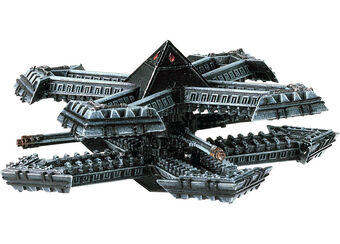
How Does the Game Play?
As mentioned, the main rulebook (linked previously) contains everything you need in a relatively digestible set of basic and advanced rules. At its most basic, the game is built on three classes of ships – battleships, cruisers, and escorts. Individual data sheets will dictate the movement, armament, hull strength, and other critical or special components including points costs and requirements to requisition such a ship. All ships in BFG will have different facings – or 90-degree arcs from their center-line. Generally speaking these are the front (bow/prow), side or abeam (port/starboard), and the rear (stern) facing. These will play a role in not just what kind of weapons may fire, but also how well you can be targeted by incoming fire.
The basic game mechanics center around four phases per player turn; movement, shooting, ordnance, and end.
Movement Phase
Like most naval simulation games, movement and facing is the most critical component of the game. How you are able to maneuver your fleet will impact not just what guns you are able to bring to bear and how well you’ll be able to strike your targets, but also how well positioned you’ll be in ensuing turns to either disengage or move in for the kill. Ships are generally required to always move a minimum distance, based on their ship class, before they are eligible to make a turn. This represents the inertia of space and the impact of trying to turn a kilometers long behemoth space cathedral. They may then make a turn up to a certain degree based on their profile and then continue the rest of their movement.
It is during the movement phase that special orders are also given. You can think of special orders as the modern version of raising signal flags on the yardarms of your mainmast – signals to the fleet to conduct certain maneuvers or gunnery conditions. These have the effect of greatly increasing one of the capabilities of your ships such as All Ahead Full boosting your speed or Lock On increasing your gunners’ effectiveness. There are six in total, and while they grant bonuses, they also come with downsides, whether it be reduced weapon effectiveness or restricting maneuverability. Your fleet’s leadership on each vessel also matters – as a failure to successfully test for a special order will stop you from issuing any new orders that turn while you desperately try to relieve and probably execute the idiot captain of the ship you’re trying to signal.
Shooting Phase
There are probably two types of players in the world – those who love the movement phase (Eldar players) and those who love the shooting phase (everyone else). The shooting phase is where you get to deliver your well planned and executed broadsides that rip giant chunks out of the opposing fleet in a blistering hail of fire. Generally speaking there are two types of weapons – lances and weapons batteries. The lances represent the high-powered low-volume pin-point weaponry that tear through opposing armor like paper. In contrast, weapons batteries release a barrage of projectiles or energy that pummel opposing fleets and overcome defenses through sheer weight of fire. Lance batteries tend to be reliable in piercing armor and are not impacted by things like intervening blast, debris, or range, but they are also low volume or expensive. Meanwhile, weapon batteries may put out a fistful of shots, but they may be negatively impacted by the opponent’s facing (harder to hit a fast moving target crossing than it is to hit a target closing or separating), intervening debris or explosions, or range. Finding the right balance in your fleet’s weaponry is a key component of fleet construction.
Many ships are equipped with shielding mechanisms that will mitigate the impact of incoming enemy fire before any damage is actually allocated – but once the shields are overwhelmed, damage that defeats a ship’s armor will start to break down a ship’s hull (wounds). Each point of damage a ship takes has the potential to do increased damage, limit ship capabilities, or start a fire on board by landing critical hits.Further, a ship reduced to half its hull points is considered Crippled and will be severely limited for the remainder of the engagement. Upon destruction, a ship may suffer catastrophic failures that result in explosions capable of swallowing nearby ships caught in the blast. Since this game was made in the halcyon days of the 90s all of these things are derived from a table on a 2d6 die roll.
Ordnance Phase
The ordnance phase is when ships disgorge their squadrons of attack craft and launch their building sized torpedoes. These types of weapons are especially valuable because both players move ordnance in each Ordnance Phase – making these especially fast. Attack craft and torpedoes come in multiple different flavors; for attack craft these are generally fighters, bombers, and assault boats which serve specific roles in the fleet and come with their own movement ranges. Fighters serve defensive and escort duties – both defending against enemy ordnance and escorting bomber squadrons on their attack runs. Bombers and assault boats are purely offense – meant to strike enemy ships beyond the protection of shielding, either doing direct damage to a ship’s hull (bombers) or seeking to damage critical infrastructure from internal attacks (assault craft). This makes some carrier capacity within a fleet essential for fending off waves of your opponent’s attacks and counter-punching with your own.
Torpedoes at their most basic are WW2 style drop and forget – straight moving weapons that are made to disrupt fleet formations and penetrate (ignoring a ship’s shields) hulls for those that cannot maneuver out of their way. Dropped at close range these can be lethal. More advanced torpedoes may have limited maneuvering capability (boarding torpedoes) and special rules similar to assault craft, or may be made to burn and start fires across the stricken ship (melta torpedoes).
End Phase
At its most basic, the end phase is the final part of the player’s turn and consists of damage control and blast marker removal. It’s the simple admin of the fleet – putting out fires, filing casualty reports, and having the bos’n ring the ship’s bell/pipe whistles at ear piercing volumes over the 1MC, thus marking the end of the turn. Under the advanced rules, or with Ork fleets, this is likely the most important phase as this is the phase where you will resolve boarding actions and lightning attacks before closing the turn.
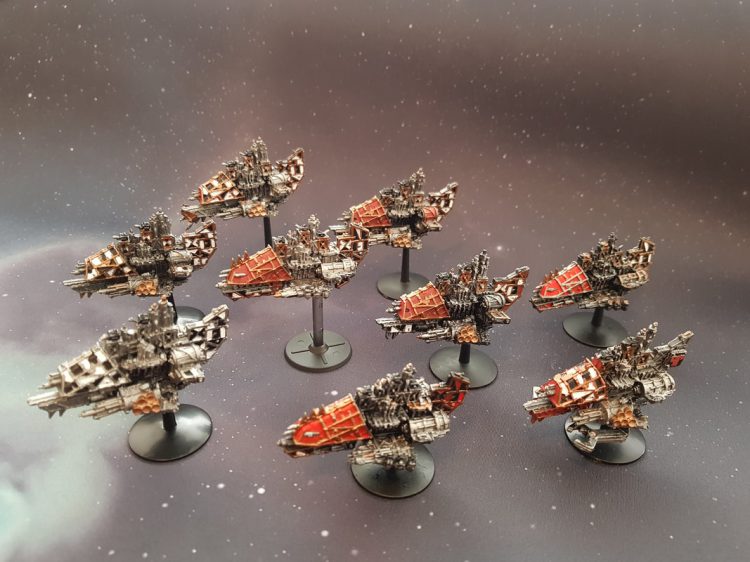
Final Notes
This should be everything you need to go out and have a kick ass space battle in the Gothic Sector. While the game originally focused on these events, expansions into other narratives and regions of space soon followed. In future articles we’ll look to examine not just the core fleets of the Gothic Sector, but the expansion fleets, and cool ways to integrate Battlefleet Gothic into your forged narratives throughout the 40k universe! If you have any questions or comments, or just want to show us your own cool BFG fleets, then get in touch on Facebook, Twitter, or contact@goonhammer.com!


